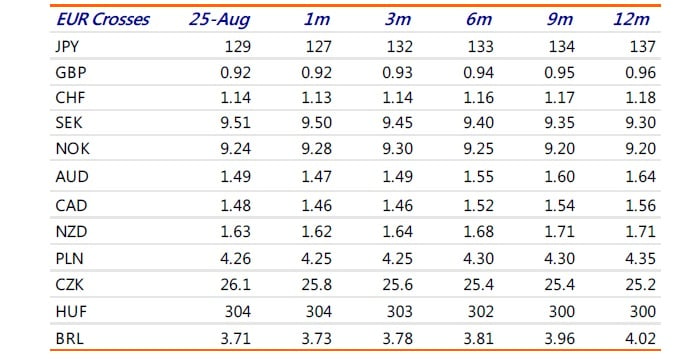Rabobank Forecast Pound-to-Euro Exchange Rate to Test Record Lows
- Written by: James Skinner

Rabobank suggest more pain is in the pipeline for those buying Euros using Pound Sterling as Brexit-related uncertainty hampers investment and economic growth. But a fall to 1.00 remains out of reach.
Economists at Dutch lender Rabobank forecast the Pound-to-Euro exchange rate (GBP/EUR) will test the record lows reached in the aftermath of the global financial crisis of 2008 when Sterling last embarked on a significant devaluation.
"There has been limited progress made on the Brexit negotiations to date and with only eighteen months to go before the UK leaves the EU, investors are finding it difficult to look through the fog of uncertainty. This week we revised lower our GBP forecasts," says Jane Foley, an FX strategist at Rabobank.
With regards to the GBP/EUR specifically, a nadir will only be reached in the weeks leading up to Brexit date; an observation that puts paid to any hopes that the Pound might soon turn direction.
The call confirms our view that an intrasigent European Union will not give an inch to the United Kingdom, thus opening the door to an acrimonious default to World Trade Organisation trade rules in March 2019.
The impact of such a move on Sterling are likely to be negative; but we note the default amongst the analyst community is that some kind of agreement, that includes a transitional deal, will be reached.
"Our central, published forecasts for EUR/GBP have been assuming that a hard Brexit will be avoided," says Foley.
Nevertheless, "many companies in the coming months are likely to start implementing plans that assume a hard Brexit, some of which are likely to be irreversible even if a softer Brexit is the eventual result," says Foley.
But, the risks for Sterling on the Brexit front nevertheless appear skewed to the downside.
"The closer March 2019 becomes without confirmation from the UK government that the economy is facing anything other than a hard Brexit, the greater the risks for investment and the Pound," says Foley.
Foley's comments come as the E.U. and U.K. are unable to find a compromise on the amount the U.K. should pay into the E.U. budget once it leaves. Furthermore, E.U. appear intransigent with chief negotiator Michel Barnier telling a conference in Italy that he sees Brexit as a chance to "teach" the British people why their decision is one that must necessarily involve pain.
Euro Climb not Done
Then there is the question of the ever-strengthening Euro which is adding pressure to the GBP/EUR pair.
“While much of the Pound’s weakness has been home-made, it has been amplified by this year’s broad-based rotation into the EUR,” says Foley.
With political uncertainty in the U.K. and the U.S. at historically high levels and sentiment toward the Eurozone having been boosted by the election of Emmanuel Macron in France, not to mention a firming economic recovery, the Euro has turned the tables on many of its rivals in 2017.
“In a year when political uncertainty is at unusually high levels in both the US and in the UK, there would appear to be an unfamiliar calm in Europe,” Foley wrote in a recent note.
The combination of pressures has seen the Pound-to-Euro exchange rate fall by as much as 8% during the eight months to the end of August and still sits some 7.49% below its January level.
What Does this Mean for the Forecasts?
Concerning the outlook, Foley believes that ongoing uncertainty regarding Brexit and an extension of the Euro's uptrend are likely to push Sterling lower than they previously had anticipated.
“The pace of the recent gains in EUR/GBP raises the question as to whether the currency pair is on course for hitting the 2009 high close to 0.98 and whether parity has become a realistic target,” Foley says.
The downside is however likely to be limited by the Bank of England which will be nervous of the upward push on inflation a decline in Sterling will trigger.
Foley sees the sharp weakening of the pound as having consequences for domestic inflation, which itself has implications for Bank of England monetary policy. It is the possible temptation of BoE rate setters to raise interest rates in response to this spike in inflation that might be what prevents the currency from falling to parity with the Euro.
The Bank of England targets inflation at 2.0%, and with inflation currently on target for 3.0% in late-2017, it can ill afford for Sterling to fall much further.
The Pound to Euro exchange rate is forecast to fall to 1.07 in three months time, 1.06 in six months, 1.05 in nine months and 1.02 in the run-up to the March 2019 exit date.
Get up to 5% more foreign exchange by using a specialist provider by getting closer to the real market rate and avoid the gaping spreads charged by your bank for international payments. Learn more here.
Euro Might have Peaked Against the Dollar
In a similar but more extreme vein, the Euro to US Dollar rate has gained 13.35% for the year to date as investors and traders have increasingly speculated that an ECB exit from its stimulus programs is nigh, while dialling back their expectations of further Federal Reserve rate hikes.
The EUR/USD pair assailed the 1.2060 level last week, marking its highest point since the ECB began its quantitative easing program in January 2015.
However, Foley and her team see this as forming a likely peak for the currency pair over the next 12 months.
The ECB is widely expected to signal its unease at the recent strength of the euro at its forthcoming press conference, scheduled for Thursday, particularly in light of the rapid pace of gains seen by the common currency.
This is while Rabobank sees the Pound to US Dollar pair is seen falling back to the 1.2500 level over the next 12 months, down from the 1.2800 seen in August.


Euro Benefits from Fresh Nerves Concerning North Korea
The Euro exchange rate complex is seen rising at the start of the new week morning as it appears to have reverted to its old relationship with global sentiment, a relationship in which it gains during crises, like the Swiss Franc and gold.
Pyongyang's increasing provocation - most recently with the testing of an H-bomb over the weekend - has led to investors pulling out of risky investments and seeking safer-havens instead. The testing of the bomb is the latest in the escalations of tensions surrounding North Korea which is adopting an increasingly aggressive stance towards its neighbours and the United States.
This has benefited the Euro which has become a favoured funding currency for risky investments due to its record low-interest rates, which essentially mean investors can borrow for next to nothing and invest the proceeds in high yielding riskier projects abroad.
Geopolitical fears brought those investments 'home' on Monday as investors unwound their riskier plays and repatriated their Euros, leading to a rebound in the single currency.
Analyst Petr Krpata at ING Bank N.V. in London notes the Euro's growing "safe haven properties" while noting the US Dollar "is falling in the pecking order of safe haven currencies within the G10 FX space."
The Euro to Pound Sterling exchange rate (EUR/GBP) rose to 0.9185 from Friday's close of 0.9157.
The Euro to Dollar exchange rate (EUR/USD) also rose to 1.1894 from Friday's 1.1859.
We do expect the Euro's advance to be contained however ahead of Thursday's European Central Bank meeting.
Just how serious North Korea is regarding the use of weapons and pushing the envelope ever further is also questionable.
"The impact on the risk sentiment may not to be long lived. This was the case last month and with risks now being well known, we are likely to observe a diminishing effect of the headline news on global markets," says Krpata.
Get up to 5% more foreign exchange by using a specialist provider by getting closer to the real market rate and avoid the gaping spreads charged by your bank for international payments. Learn more here.




